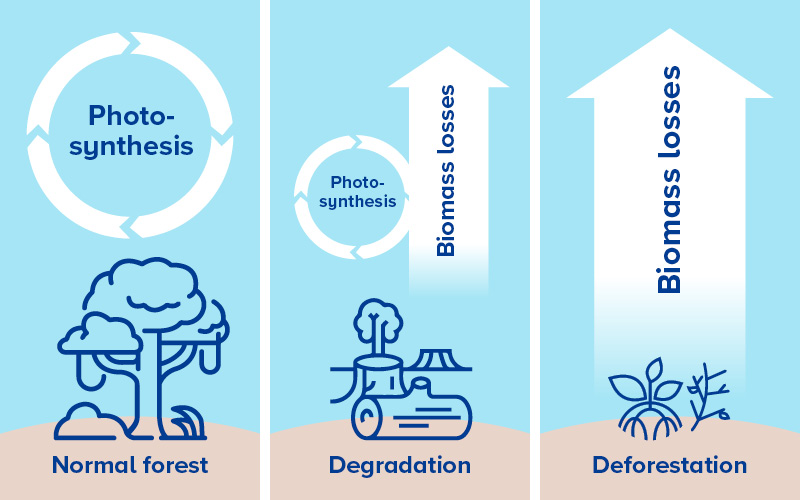
What is deforestation?
Deforestation is the intentional clearing of forested land to make space for agriculture and livestock pasture, and to cut and process wood for fuel, manufacturing, and construction. Today, rainforests are where most of worldwide deforestation occurs, especially in tropical regions for logging, cattle grazing, and plantations.
Tropical deforestation is the cause for around 20% of annual greenhouse gas (GHG) emissions around the world. Therefore, reducing deforestation has one of the largest potentials for reducing GHG emissions to mitigate climate change.
Environmental effects of deforestation
Because forests are extremely effective at sequestering carbon through capturing CO2 from the atmosphere and converting it into biomass via photosynthesis, deforestation releases a vast amount of carbon back into the atmosphere. It not only reduces the effectiveness of carbon sinks (reservoirs that absorb and store carbon), but also converts them into a carbon source, which releases more carbon than it stores.
Deforestation also has a big impact on the water cycle without the trees’ ability to regulate the humidity and moisture in the soil, leading to higher rates of erosion and flooding. In addition, most of the planet’s animal and plant species reside in forests; biodiverse habitats will continue to decline as more species go extinct without forests.
 |
Causes of deforestation
The main sources of deforestation are:
- Commodity-driven, including permanent conversion of forests into land for agriculture, mining, and oil and gas production
- Wildfires, which are increasingly exacerbated by climate change, making it even more difficult to regenerate forests
- Shifting agriculture, which is the clearing or burning of land for the short-term cultivation of crops
- Urbanisation
- Forestry, although the dominant driver of deforestation, has recently developed certification mechanisms to ensure that the harvesting and re-growing of trees is sustainable in the long-term by providing social and environmental benefits
Measuring rates of deforestation
Before providing solutions, it’s important to accurately measure rates of emission related to deforestation. At COP28, the EU established observatories on deforestation and forest degradation to be able to monitor forests and the production of commodities. Technologies and methods are currently in place that can be utilised globally, but the main barriers to doing so are political and financial.
Two measurements are needed to estimate GHG emissions from deforestation: forest cover rates of change and the carbon stock. Forest cover refers to the number of trees physically covering land, measured in hectares, while carbon stock is the measurement of carbon in an area, in tonnes of carbon per hectare.
Solutions to deforestation
The voluntary carbon market is an effective tool for companies to generate funds for climate projects. This is especially useful, for instance, in making living forests more profitable than deforested or degraded ones. Conservation and restoration should be used against industries and practices that lead to deforestation, which is where most subsidies are provided.
The EU’s Regulation on Deforestation Free Products, which goes into force on the final day of 2024, will make sure operators and traders place commodities (wood, palm oil, etc.) on the EU market that do not originate from recently deforested land or contribute to forest degradation.
With global wood consumption growing, forestry management projects are needed for reforestation, conservation, and protection. The UN created the REDD+ mechanism to involve local populations in forest conservation. Verified emission reductions can be generated from these protection efforts and sold, which creates revenue that is then invested in long-term forest management mechanisms and resources. This results in both positive social benefits for local communities through nature-based solutions and help preserve one of the largest carbon sinks in the world.
Learn more about climate projects and how ClimatePartner can help you contribute.